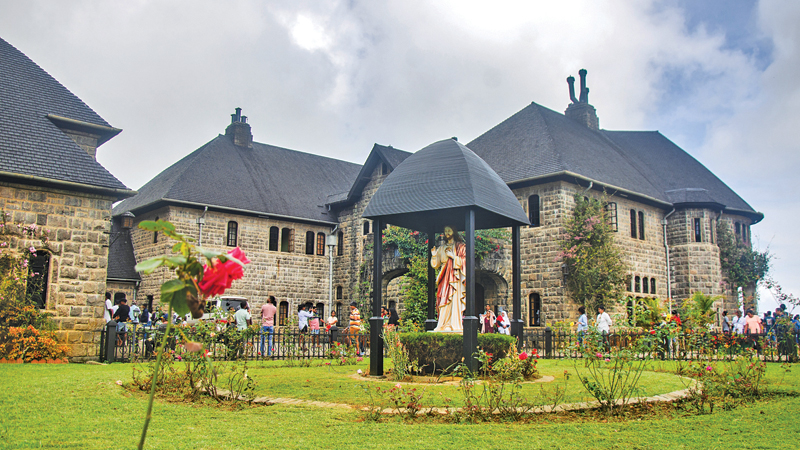 Haputale is a mist-laden hill country town, 1,431 metres (4695 ft) above the sea level, in the Badulla District of the Uva Province. The area, surrounded by hills covered with cloud forests and tea plantations, has a rich bio-diversity with numerous varieties of flora and fauna. The town has a cooler climate than its surroundings, due to its elevation.
Haputale is a mist-laden hill country town, 1,431 metres (4695 ft) above the sea level, in the Badulla District of the Uva Province. The area, surrounded by hills covered with cloud forests and tea plantations, has a rich bio-diversity with numerous varieties of flora and fauna. The town has a cooler climate than its surroundings, due to its elevation.
The Haputale pass allows views across the Southern plains of Sri Lanka. The South-West boundary of the Uva basin is marked by the Haputale mountain ridges, which continue on to Horton Plains and Sri Pada to the West. We had an opportunity to visit this misty town and its surrounding places of interests during our recent visit.
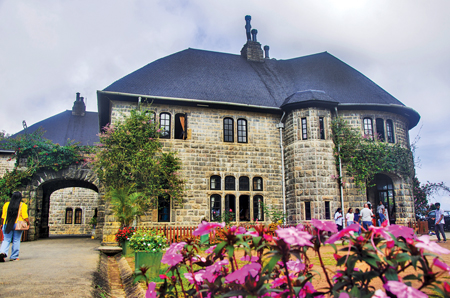
Adisham Bungalow in Haputale
Adisham bungalow is an attraction not to be missed by an enthusiastic visitor to the area. A 3-kilometre drive from Haputale town will lead you to this absolutely palacious place. Adisham Bungalow, built in the British period in the nineteenth-century, now, a monastery run by Benedictine Monks, is wrapped in the tranquility of the misty hills. Surrounded by a birds’ sanctuary and a thick forest cover, the Bungalow is an ideal place for you to enjoy nature. The Thangamale Birds’ Sanctuary is next to the bungalow.
The narrow road which leads to the site of uphill climb under a forest canopy is a bit irksome to the visitors who travel in vehicles due to the narrowness of the road. We parked our vehicle on the edge of the road and walked about a kilometre to the place because of traffic congestion.
Benedictine monastery
Adisham is the kind of place seekers of peace dream about. Now, a Benedictine monastery where tranquility lies like a blessing and the grandeur of sweeping mountain vistas takes your breath away. Adisham was originally the country seat of Sir Thomas Lister Villiers, a distinguished British resident in the colonial period of Ceylon. The spirit of Thomas Villiers pervades in this stately house.
Villiers came out to Ceylon in 1887 with £10 in his pocket. He was born in 1869 in Adisham Rectory in Kent, the son of Rev. Henry Montagu Villiers. He was a grandson of Lord John Russell, twice Prime Minister of Great Britain, whose another grandson was world renowned Mathematician and Philosopher Bertrand Russell.
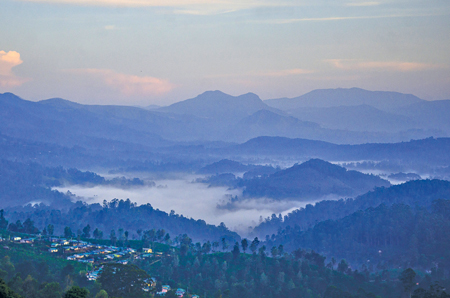
The Haputale mountains seen from Adisham
Villiers received a public-school education, but instead of settling down to a business or political career in England, chose adventure in the colony of Ceylon. Soon after his arrival, he began life here as a trainee “creeper” planter on Elbedde Estate, Bogawantalawa. In 1896, he married the daughter of a tea planter and went to Brazil.
He returned to Ceylon four years later and soon began his own tea estate, Dikoya Group.
In 1905, Villiers joined the firm of George Steuart, a leading sterling trading and estate agency house in Colombo, and rose to be its chairman in 1928, a position he held till his retirement in 1948. He also played a major role in Ceylon politics.
It was while he was chairman of George Steuart that Villiers commenced building a dream home in the country. He selected an idyllic site at Haputale, surrounded by virgin forest and commanding views across hills, dales and valleys, of all the highest mountain ranges of Ceylon. The foundation stone for the bungalow, which comprises 40 rooms, was laid in 1927 and construction work was completed in 1931.
The house was designed in the Tudor style, on the lines of Leeds Castle in Kent, with stout granite walls of locally quarried stone, long, narrow turret windows and chimneys. It looked in every detail an Elizabethan country mansion, the retreat in the tropics of a homesick Englishman, nostalgic for the scenes of his boyhood.
Villiers spared no expense to ensure that his country home was luxurious in its appointments. The entire roof was covered with flat Burma teak shingle tiles; the doors, windows, paneling, staircase and floors were also of fine seasoned Burma teak and the elaborate pillared landing on the main staircase adorned by portraits of his relatives.
Sanctuary for social elite
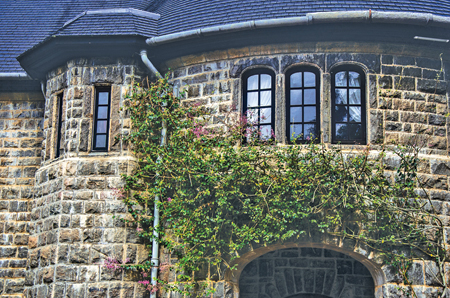
The front of the granite-stone built building
Villiers imported fine period furniture, linen, carpets, porcelain, silver, and glassware from England for his home and named it Adisham after the Kentish village where he was born. English tea and cabbage roses bloomed on the lawns.
Adisham entertained the social elite of Ceylon at the time; its house parties included many British Governors and distinguished visitors to the island.
Lady Villiers, chatelaine of Adisham, was a gracious, gentle person and a charming hostess. She was a painter of considerable skill; her oil paintings and water colours (mostly of marine subjects), adorn the walls of the library and the drawing room. Sir Thomas Villiers retired to Kent and died on December 21,1959.
In 1949, after Villiers left George Steuart, Adisham and its furniture, fittings and other effects were sold to the Sedawatte Mills. In 1961, the occupants sold it to an Italian Benedictine monk.
Upon purchasing the house and property, the Italian monk removed silver cutlery and a few items of furniture to recover his investment and also make a profit. After leaving it unoccupied for two years, he subsequently donated the house and property to the Ampitiya Benedictine Monastery in 1963.
Today, the spirit of Sir Thomas and Lady Villiers lingers in their living rooms kept in impeccable order by the Benedictines. The library, with its vast collection of books and its cupboards of polished oak is meticulously orderly – even the Regency clock on the mantelpiece of the handsome fireplace.
The air windows of the bungalow amaze even modern architects. Access to the whole house is limited and visitors are allowed to see only the library and living room. However, they are not permitted to photograph the inside.
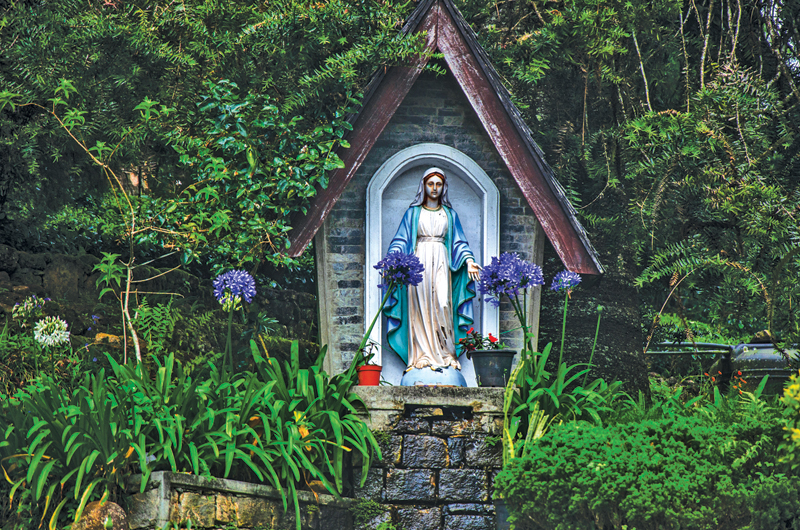
The statues erected in the flower garden of Adisham








